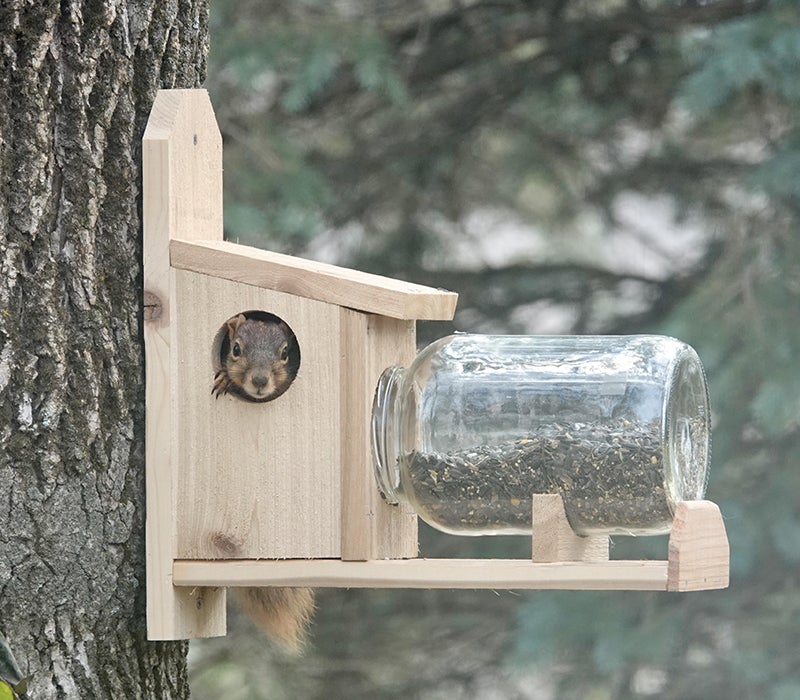Al Batt: What percentage of their body weight do certain birds eat daily?
Published 9:00 am Saturday, December 22, 2018

- A squirrel feeder feeds a squirrel. The feeder was built by Jerry Determan of Fairmont. - Al Batt/Albert Lea Tribune
Al Batt of Hartland is a member of the Albert Lea Audubon Society. Email him at SnoEowl@aol.com.
My neighbor Crandall stops by.
“How are you doing?” I ask.
“Everything is nearly copacetic, but I think it’s time the weather adjusted to my liking. I have a satellite TV dish. I get too many channels. I get so many, I found myself watching an infomercial about enema kits. I found it moving. I subscribed to the dish because I got a deal with my Bumper Sticker of the Month Club membership. This month’s sticker was, “Forget world peace, visualize using your turn signal.” You know, I didn’t get a Fulbright Scholarship. I got a PhD (posthole digger) on a Halfbright Scholarship and you, neighbor, are the only fruitcake I can abide. I wish you a Merry Christmas.”
Naturally
I got a nice Christmas card from a Baltimore oriole. It said he was warm and eating fruit and nectar in Costa Rica. After reading the card, I moved to a pretty place: the window.
There were chickadees at the feeders. My favorite bird eats about 35 percent of its weight per day. A Cooper’s hawk had been hunting/haunting the yard. That raptor eats 12 percent of its weight daily.
It was 10 degrees, and an opossum was nibbling on seeds that had fallen from feeders. I was eating an apple. I tossed the apple core outside, nearly hitting the opossum. I didn’t mean to come that close. It didn’t alarm the animal. An opossum’s eyesight isn’t the greatest, but it smelled the apple and grabbed it with its mouth of 50 teeth and ambled away. I felt good about my simple gift.
I ventured outside to enjoy the winter wonderland. I walked as if I were wearing gravy boats for shoes. It was that icy.
A male house sparrow in the yard had an impaired wing. Birds don’t fly well on one wing. I tried to catch the little bird, but it was too quick for me. I’ve been feeding it. Many would say that it’s just a house sparrow. Even though I’m more than willing to trap a mouse or swat a mosquito or stable fly, I try not to judge creatures. They are what they are. The house sparrow’s popularity does exceed that of the starling. Rachel Carson, author of “Silent Spring,” said this of the starling: “In spite of his remarkable success as a pioneer, the starling probably has fewer friends than almost any other creature that wears feathers.” I remain hopeful on the sparrow’s behalf.
Some trees have held fast to their dead and dried leaves. This leaf retention is called marcescence and is common in some oak species and ironwood. Marcescence is most common with smaller trees and the reduced sunlight when growing beneath taller trees might slow abscission (the natural detachment of the leaves). The understory leaves might continue the photosynthetic process as upper leaves fall. Some speculate the retained leaves deter browsing animals, such as deer, by concealing the buds. Perhaps by holding onto their leaves, trees are able to retain and recycle nutrients.
The night before, my wife and I had been awakened at 2:30 a.m. in the morning by a coyote cacophony. It sounded like a celebration. Coyote mating season is January and February. Five to seven pups are born in April. Their mother teaches them to hunt when they are 8 to 12 weeks old. From autumn until mid-winter, the pups leave the den and search for their own territories.
I saw where crows, coyotes and a young bald eagle had been feeding upon a dead deer. Deer are nature’s living “reduce speed” signs. Just think how fast people would drive if it weren’t for deer.
Fountain Lake Book Store
I love to read. This lifetime addiction has caused me to own far more books than I’ve room for. I’ve been hauling many boxes of lovely books to the Fountain Lake Book Store on the first floor of City Hall in Albert Lea. A great number of recently published, once-read nature books are looking for good homes. The book store is manned by terrific volunteers who welcome book donations. The books for sale are beyond reasonably priced.
Albert Lea Christmas Bird Count
The Christmas Bird Count will take place Dec. 29. Feeder counters are welcome. For more information, contact me at snoeowl@aol.com or 845-2836.
Q&A
“I found a small nest low in a tree with blue eggs in it this past summer. What kind of bird made it?” Sounds like a chipping sparrow nest. They typically build nests low in a shrub or tree.
Thanks for stopping by
“If you truly love nature, you will find beauty everywhere.” — Vincent Van Gogh
“The wind lifted me up into the trees, where I danced to the rhythm of the evergreen. Swaying to the tune of the northern breeze, frozen in timeless melody — Christy Ann Martine
Do good.
Merry Christmas.



